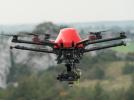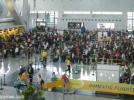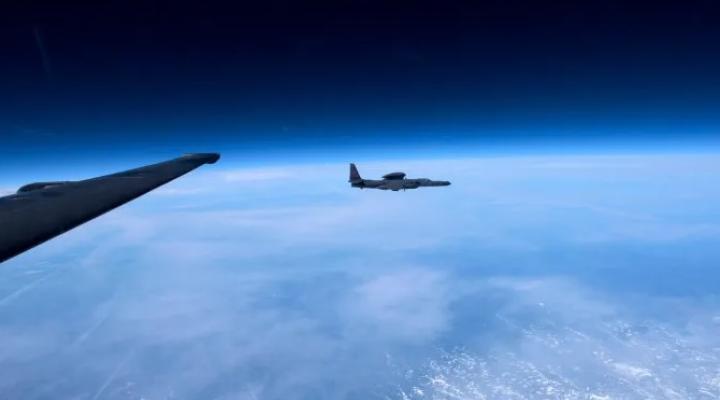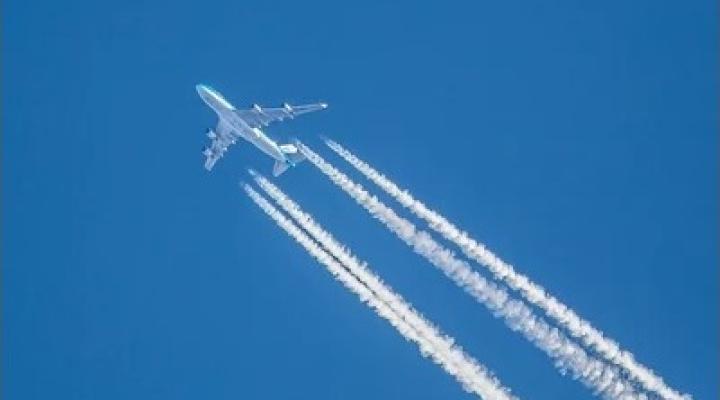Atlas B742 at Dusseldorf on Jan 24th 2005, overran runway on landing
An Atlas Air Boeing 747-200, registration N808MC performing flight 5Y-8995 from Dubai (United Arab Emirates) to Dusseldorf (Germany) with 3 crew, was descending towards Dusseldorf when the crew checked ATIS and in repeated communication with approach control and tower was assured braking action would be good for landing at runway 23L, snow fall had started again and they had just had conducted a new measurement as result which again showed good braking action. The captain (55, ATPL, 20,000 hours total, 2,300 hours on type) subsequently decided to use medium auto brakes for landing "for the snow". The crew intercepted the localizer and was handed off to tower, who reported a new measurement had just been done showing medium braking action all along the runway. The crew selected flaps 30, the aircraft was cleared to land about 2.5nm from touchdown, winds were reported from 320 degrees at 11 knots. The aircraft touched down on runway 23L about 1100-1600 feet past the runway threshold at a speed of 157 KIAS (6 knots above Vref) at +1.2G vertical acceleration. Speed brakes deployed and thrust reversers were engaged, 100% reverse thrust was applied for about 20 seconds then reverse thrust was reduced to idle, initial good deceleration decreased. The pilot monitoring called out 80 knots, the captain, pilot flying, realised they were still fast and reapplied reverse thrust and applied manual braking slowing the aircraft to 60 knots 10 seconds later. The captain remarked "Still 50", one of the crew members responded "we are going off". The aircraft continued for another 15 seconds, then the captain announced "we got fires", the first officer (58, ATPL, 14,600 hours total, 3,000 hours on type) radioed tower informing tower of the runway overrun and engines #2 and #3 on fire. The aircraft came to a stop about 580 meters/1900 feet past the runway end after colliding with the localizer antenna. The captain ordered the fire drill. After both fire bottles were discharged engine #2 still indicated on fire, the crew decided to evacuate the aircraft. Tower confirmed seeing fire, then advised the doors were blocked from the outside and queried whether the crew could evacuate on a different route. The crew exited the aircraft through the electric and electronics compartment and down near the nose gear. First fire engines arrived at the aircraft 5 minutes after the overrun. There were no injuries, the aircraft received substantial damage beyond repair however.
Germany's Buero fuer Flugunfalluntersuchungen (BFU) released their final report more than 8 years later concluding:
The air accident is due to the fact that the braking action values reported to the crew did not correspond with the runway conditions which had changed because of the heavy snowfall since the last measurement.
The following factors contributed to the air accident:
- The high dynamics of the weather changes
- The lack of a measurement method providing reliable braking coefficient values under all weather conditions.
The BFU reported that the localizer antenna was destroyed at a width of about 30 meters, the approach lights runway 05R were destroyed. Parts of the localizer antenna were found in the engines, the fuselage and wings also showed damage consistent with impacting the localizer antenna. The entire engine #2 intake up to the fan had separated, fire had destroyed the left engine fairing in the area of the fan and the low pressure compressor. Fan blades of engines #2, #3 and #4 were damaged.
The BFU reported that computation of the various variables recorded by the flight data recorder showed, that the braking action available at Dusseldorf was poor or worse at the time of landing in Dusseldorf.
The BFU analyzed that the driver of the measurement vehicle had reported the values correctly and conservatively. The measurement 45 minutes prior to the arrival found friction values of 68, 59 and 52, which was correctly identified as good braking action. The BFU stated: "the driver indicated the non-critical condition of the runways. However, he also advised of the possible worsening of the condition and emphasised his willingness to undertake another friction survey and monitor the runway condition."
About 10 minutes prior to arrival another measurement was requested, the driver commenced the measurement and report 4 minutes prior to landing values of 47, 32 and 29 (mean braking action 0.36 medium to good), however due to difficulties with the printer he reported to ground a medium braking action. The BFU stated: "This shows that the driver had attentively and correctly observed the friction survey. His estimation medium was more conservative than the actual mean measurement result."
The ground controller receiving the values however was not clear with the driver report and queried, the driver clarified that he had mainly observed values in the 30ies and occasional 25s. The BFU stated: "This confirmed a braking action of medium or medium to poor with partially even
worse values."
This worsened braking action report was relayed to the crew by tower about 30 seconds prior to touch down when tower stated: "the braking action was measured to be medium in all parts".
The BFU summarized: "The accident shows that the airport personnel made an effort to achieve a proper runway condition. In addition to the precautionary de-icing of the runway, friction surveys were conducted to determine the braking coefficient. The last friction surveys were conducted immediately prior to the landing of the airplane.
The BFU is of the opinion that this accident emphasises that under the prevailing weather conditions and the existing friction coefficients the used friction tester is appropriate for the planning of winter services but does is not reliably usable for flight operations. This confirms the findings which the Norwegian accident investigation authority and the ICAO Friction Task Force determined in the meantime."
The BFU analyzed: "The five minutes between the fire brigade being alerted by the tower and the first fire trucks arriving at the accident site were significantly more than what ICAO requires. However, the ICAO requirements are valid for optimal conditions. The poor visibility and the snow-covered operating areas slowed down the fire brigade."
Aerial overview (Photo: BFU/Police):
Aerial detail (Photo: BFU/Police):
Engine #2 damage (Photo: BFU):
Engine #3 damage (Photo: BFU):
The blocked main door (Photo: BFU):
http://avherald.com/h?article=46d4a594














Komentarze